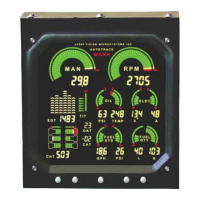VM1000C Pilot’s Guide Page
33
The fuel level probes are designed to be installed in virtually all types of
wing tank configurations. The basic objective are to install the probe so
that it can sense the fuel level change from full tank to empty tank (i.e.
the probe is wetted the least at empty tank and is wetted the most at full
tank) and to position it in such a manner as to allow insertion and
removal.
The probe may be cut to a minimum of 16 inches in length overall (metal
end to metal end) and mounted in any direction. Internal spacers are
located approximately every foot that supports the inner rod and crimp
the rod to prevent it from moving.
See the drawing in illustration section for an example probe installation.
These are intended as examples only. As each tank configuration may
be different, it is your responsibility to design and implement a proper
installation method for your aircraft.
The example shows a cross section of a typical long, flat wing tank.
Typically the probe enters the tank from the inboard fuel bulkhead and
angles upward so that it is wetted from empty tank to full tank
proportionately. Insure that nothing interferes with the probe such as a
flop tube, fuel pick-ups, vents or drains, etc.
The probe may enter a fuel tank from the bottom up or vice versa as long
as the probe sees at least an 85% coverage change from full to empty.
The following notes should be observed to aid in the proper installation of
the probes. See the illustration below.
NOTE 1: Mounting flange installation ( Metal knurled flange).
For composite aircraft, the metal mounting flange is “potted” into
the tank closeout rib at an angle as dictated by probe placement
in the tank. INSURE that the flange edges are surrounded by a
generous margin of the potting and that 3 layers of laminate are
l
aminated over the potted areas. This is necessary to insure that
the flange is “fuel tight”, mechanically rigid and will not be
cracked loose during fuel probe installation or vibration in use.
For metal tanks, the mounting flange is a weldable aluminum
alloy allowing many attachment options.
NOTE 2: Bushing installation (white bushing)
The probe (if longer than 48 inches) should be supported in the
middle. Install a bushing in the middle rib or baffle using the fuel

